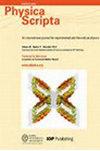早期和晚期观测张力:通过重子声学振荡实现霍拉瓦-利夫希兹引力中的暗能量参数化
IF 2.6
3区 物理与天体物理
Q2 PHYSICS, MULTIDISCIPLINARY
引用次数: 0
摘要
我们利用巴尔沃萨-阿尔卡尼兹(BA)和贾萨尔-巴格拉-帕德曼纳班参数(JBP)作为广义相对论的替代方案,在霍拉瓦-利夫希茨引力框架内研究晚期宇宙膨胀。在紫外尺度上引入了各向异性缩放。我们的目的是通过将(rd)视为自由参数,利用关键的重子声振荡(BAO)尺度,特别是声平线(rd)来约束每个宇宙学参数。我们采用了来自宇宙计时器的 30 个哈勃参数测量值(H(z)),以及 Ia 型超新星、伽马射线暴、类星体和 24 个不相关的 BAO 测量值,跨度从 z = 0.106 到 z = 2.33。分析将里厄斯(Riess)的 2022 年哈勃常数测量结果(R22)作为额外的先验值,并通过模拟协方差矩阵中的随机相关性来尽量减小误差。在 BA 和 JBP 框架中,利用全部数据集得出的声平线结果分别为 rd = 146.5399 ± 2.4519 Mpc 和 rd = 146.4533 ± 2.4519 Mpc。如果加入 R22 的结果,声平界值则分别为 rd = 143.4721 ± 1.8324 Mpc 和 rd = 142.9826 ± 1.9084 Mpc。这些发现揭示了早期和晚期观测之间的差异,与 H0 张力相呼应。值得注意的是,排除 R22 后,rd 与普朗克和 SDSS 的结果一致。根据哈勃测量和ΛCDM范式对模型预测进行了评估。利用宇宙学检验对 BA 和 JBP 模型进行的比较研究表明,两个模型都能在幻影区域内无缝拟合。统计分析表明,根据最新的观测测量结果,两种模型都不能被排除。本文章由计算机程序翻译,如有差异,请以英文原文为准。
Early and late observational tension: dark energy parametrizations in horava-lifshitz gravity via baryon acoustic oscillations
We investigate late-time cosmic expansion within the Horava Lifshitz gravity framework using Barboza Alcaniz (BA) and Jassal Bagla Padmanabhan Parametrizations (JBP) as alternatives to general relativity. Anisotropic scaling is introduced at ultraviolet scales. Our aim is to constrain each cosmological parameter using the crucial Baryon Acoustic Oscillation (BAO) scale, specifically the sound horizon (rd), by treating (rd) as a free parameter. We employ 30 Hubble parameter measurements (H(z)) from cosmic chronometers, along with Type Ia Supernovae, Gamma-Ray Bursts, Quasars, and 24 uncorrelated BAO measurements spanning z = 0.106 to z = 2.33. The analysis includes the 2022 Hubble constant measurement by Riess (R22) as an additional prior and aims to minimize errors by simulating random correlations in the covariance matrix. In both the BA and JBP frameworks, utilizing the full dataset yields sound horizon results of rd = 146.5399 ± 2.4519 Mpc and rd = 146.4533 ± 2.4519 Mpc, respectively. When incorporating R22 results, the sound horizon values become rd = 143.4721 ± 1.8324 Mpc and rd = 142.9826 ± 1.9084 Mpc. These findings reveal a discrepancy between early and late observations, echoing the H0 tension. Notably, excluding R22 aligns rd with Planck and SDSS results. Model predictions are evaluated against Hubble Measurements and the ΛCDM Paradigm. A comparative study between BA and JBP Models using the Cosmography test shows both models fitting seamlessly within the phantom region. Statistical analysis suggests neither model can be ruled out based on the latest observational measurements.
求助全文
通过发布文献求助,成功后即可免费获取论文全文。
去求助
来源期刊

Physica Scripta
物理-物理:综合
CiteScore
3.70
自引率
3.40%
发文量
782
审稿时长
4.5 months
期刊介绍:
Physica Scripta is an international journal for original research in any branch of experimental and theoretical physics. Articles will be considered in any of the following topics, and interdisciplinary topics involving physics are also welcomed:
-Atomic, molecular and optical physics-
Plasma physics-
Condensed matter physics-
Mathematical physics-
Astrophysics-
High energy physics-
Nuclear physics-
Nonlinear physics.
The journal aims to increase the visibility and accessibility of research to the wider physical sciences community. Articles on topics of broad interest are encouraged and submissions in more specialist fields should endeavour to include reference to the wider context of their research in the introduction.
 求助内容:
求助内容: 应助结果提醒方式:
应助结果提醒方式:


